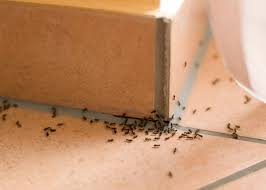Five Minutes With Sprague Entomologist Dr. Richard Houseman
What are a few ants around the outdoor patio of a restaurant or next to the loading dock of a commercial bakery or dairy processing plant?
While harmless looking, ants can carry bacterial and disease-causing organisms that can contaminate food and lead to food-borne diseases, including E. Coli and salmonella. Their presence in a food processing, restaurant or healthcare facility will raise a red flag with auditors and inspectors.
Ants seen trailing into a building are worker ants searching for food for the colony. And it’s safe to assume that if you see one ant there are many more nearby. Finding the right solution depends on identifying the type of ant that’s causing the problem.
What Attracts Ants to Commercial Properties?
The spring season sees the greatest increase in ant pressure and activity levels in and around commercial properties, according to Dr. Richard Houseman, regional entomologist with Sprague.

Dr. Richard Houseman
What attracts ants to commercial properties?
Houseman says ants are primarily outdoor pests and are attracted inside commercial properties in search of food, and to get away from overly moist conditions resulting from spring rains.
“Ants respond to food sources and if they come up short on the outside, they’ll look inside,” says Houseman. “Nests next to structures can explode and can cause problems for property managers and business owners.”
Houseman says ants will take advantage of expansion joints, plumbing and utility penetrations and landscape and construction features including tree branches, electrical wires, gutters, etc. to gain access to a structure. And don’t think ants are just a threat at ground level. Soil nesting ants – like pavement ants – can climb trees or building features in pursuit of an opening to get inside.
Ants will likely be seen carrying food back outside to feed the colony. Following this trail can help pinpoint the location of the nest or the access point they are using. Ants are opportunistic feeders and are attracted to a variety of foods, preferring foods that are high in sugar and proteins.
Where Are Ants Found in Commercial Properties?
Once inside a commercial facility, ants will seek out food and moisture sources in kitchens, break rooms or in wall voids or under slabs near hot water pipers, in machinery compartments of food processing equipment and beneath leaky fixtures. On the exterior, they are often found under broken sidewalks or concrete slabs.
It is important for clients to remember that an effective ant management program is not an overnight process. Because of their behavior patterns, biology and large colony sizes they won’t disappear instantly following a treatment.
Property managers and business owners across Sprague’s multi-state service footprint, can encounter a variety of ant species.
One of the more universal ant species is the Odorous house ant. This species is recognized for its ability to quickly establish satellite nests that can include thousands of members.
Odorous house ants are known to move their nests multiple times and they like to eat sugary foods. That is why food spillage and waste found in commercial kitchens, bakeries, candy or beverage production facilities makes them prime targets.
In California, Argentine ants are the primary threat. Like the odorous house ant, Argentine ants form large super colonies.
The soil nesting pavement ant can be found nesting under hard surfaces – sidewalks or concrete slabs – and will expand its colony size quickly in search of food and shelter.
Carpenter ants are more than an annoyance and present a threat to the structural integrity of commercial properties. They will nest in moisture damaged wood and will hollow out the interior of wood beams and supports.
Ant Proofing Your Commercial Property
How do you prevent ants from becoming an issue? Focusing on exclusion and sanitation practices and modifying the physical environment in and around your facility is where effective ant management starts.
- Exclusion – How are ants getting in and what can be done to keep them out? Seal cracks in the foundation, install door sweeps and caulk around door frames. Seal cracks and crevices in slab floors.
- Sanitation – Clean up food spillage and debris and deep clean food processing or storage equipment to make your interior spaces less attractive to these invasive social insects.
- Environmental modification: Your commercial property is not an island, and the nearby environment can impact pest pressure. Weeds provide harborage and tree branches touching a building provide access points. Eliminate moisture sources – leaky faucets, irrigation systems or standing water.
For more information on how Sprague Pest Solutions can assist you create and deliver an effective ant management program for your commercial facility, call 855.805.0755.

